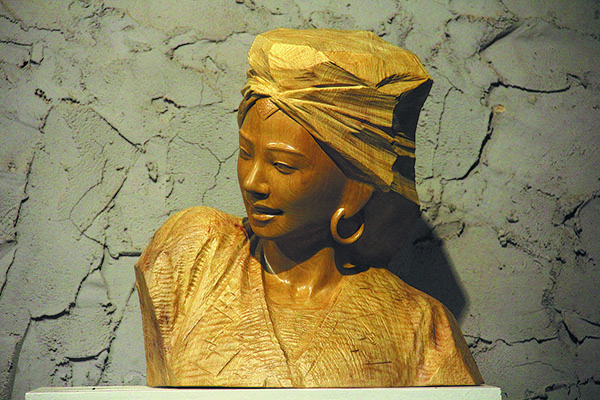

In addition to sand and stone paintings, woodcarving and ancient architecture models by local artists also drew attention.
The vivid portrait of a girl from the Yao ethnic group and Buddhist figure carved out of wood and roots by artist Pan Kui impressed participants from home and abroad.
Pan says woodcarving explores the relationship between humans and wood and, in some cases, transforms the decayed into the magical.
By using natural materials and blending traditional Chinese ink painting elements with decaying wood from the mountains, the pieces acquire a sense of depth and evoke the dynamic, expressive effects of ink brushwork, he adds.
"No two handcrafted wooden carvings are the same. Even if carved by the same person from similarly sized pieces of wood, two seemingly identical carvings will have subtle differences," he says.
Junichi Kumada, chief consultant with JTB Tourism Research and Consulting Co., was impressed by the presentation of cultural heritage elements.
The activities are mostly related to cultural and natural aspects and thus help travelers from outside better understand the region, Kumada says.
He proposes that destinations like Guilin make more efforts to foster and support local artists through tourism.
"More mini-shows featuring intangible cultural heritage can be performed to address the history and background of Guilin, creating a common understanding between locals and visitors," he says.
Guo Qingyang, who is studying tourism management at Colorado State University in the United States, is also impressed by the presence of intangible cultural heritage at the forum.
"These intangible cultural heritage creative products are especially appealing to young people," says Guo from Hubei province.
"The handcrafted wooden models of ancient architecture are both eco-friendly and cool, while the hand-painted Lijiang stone art interactions are unique and interesting," he adds.
According to the Pacific Asia Travel Association, the number of international tourists to the Asia-Pacific region is expected to increase from 619 million in 2024 to 762 million in 2026, showing strong growth momentum.
Experts at the forum agree that local traditions like intangible cultural heritage can play a positive role in adding to the travel experiences of international visitors.